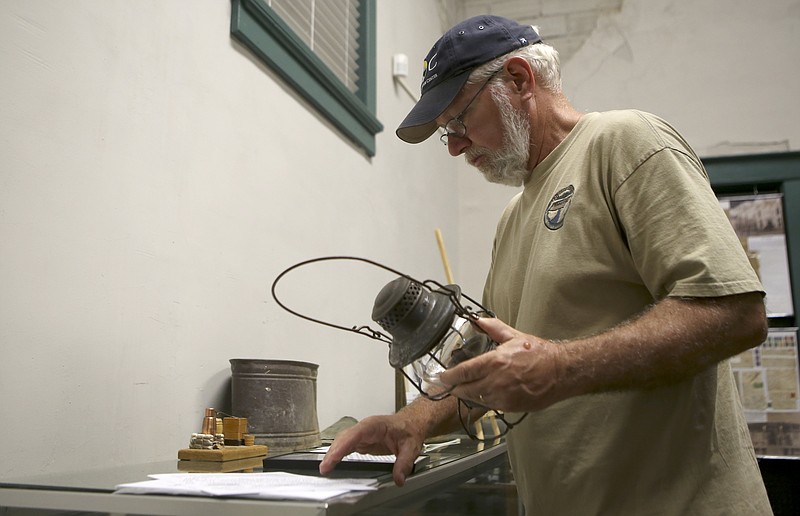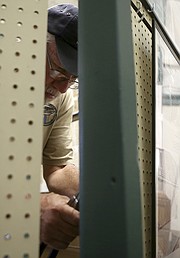If you go
› What: Good Old Days Museum, 11298 Wall St., Soddy-Daisy.› When: 9 a.m.-4 p.m. today (during Fourth of July festivities at Soddy Park) and 9 a.m.-4 p.m. Fridays and Saturdays through summer.› Admission: $3 adults and children 12 and older; free to younger children and members of the Soddy, Daisy & Montlake Historical Association.› Phone: 423-718-0528.
Another chink in the story of the area's mining history will be filled in today as the Good Old Days Museum opens in a historic building in Soddy-Daisy.
The 1,600-square-foot museum is a dream come true for core members of the Soddy, Daisy & Montlake Historical Association. The association officially organized in September 2015, but for years several key players in the effort have been accumulating artifacts and information that tell the story of Soddy-Daisy - its Indian and pioneer settlers; history of coal mining and other industry; the expansive branches of family trees.
"We've got a lot of stuff to show for as small as we are," says Steve Smith, president of the 100-member nonprofit association.
The Soddy-Daisy facility is just the latest in an unofficial network of museums around the region that tell the stories of their communities. While each collection may be hyperfocused, together they represent key components of the history of the region at large.
Coal mining is a big part of that look back.
"Mining is what started the industrial revolution in this area," says Carson Camp, vice president of the Sequatchie Valley Historical Association and a board member of the Dunlap Coke Ovens Museum, which opened in 1989 to preserve Sequatchie County's mining history.
"Until mining came along - as good or as bad as it was - it was the first time people saw a paycheck," he says. "It was a barter system prior to that."
Online histories detail coal mining's radical transformation of Southern Appalachia following the Civil War. The U.S. had entered into a frenzied period of industrialization, and coal was needed to fuel the factories and railroads that were spreading across the country.
The Moonlit Road, which chronicles Southern culture, history and travel at themoonlitroad.com, records that the first coal mines in the region were run by small local operators with little financing. After the war, "independent coal barons from outside the region set up shop throughout the hills, with better equipment and deeper pockets."
Demand for coal increased with World War I, triggering a coal boom that, at its height, had nearly 12,000 mines operating in Southern Appalachia, employing more than 700,000 men, says the website.
Smith can easily rattle off the names and dates of the coal companies that figure into Soddy-Daisy's mining history, as well as the local lore that accompanies the documented stories. Durham Street, for example, named for the Durham Coal Co., was known by old-timers as Black Track, a reference to the coal dust that collected along the route as coal was brought from the tipple at the foot of the mountain to be loaded onto barges where Big Soddy Creek flows into the Tennessee River.
One of the highlights of the museum is a rebuilt coal car set up to look as if it's coming out of Soddy Coal Co.'s old No. 7 mine.
Much of the car is original, "and parts we couldn't find we made to exact specifications," Smith says.
Though now considered a single city after incorporating in 1969, Soddy and Daisy have their own identities in early records. Both were thriving coal towns until the 1930s. A hosiery mill, turpentine plant and several pottery and tile kilns also were active in the towns' industrial days.
The museum is housed in the old Soddy Bank building on Wall Street, at one time the center of the Soddy business district. A section of nearby highway was the first in Hamilton County to be paved, and Smith says people came from all around to drive on the new concrete road.
One of Daisy's claims to fame was Poe's Tavern, the first seat of Hamilton County government in 1819. A replica of the historic structure was completed in 2013 about a block from where the original sat.
Now retired from TVA, Smith, 60, says he has been actively gathering records and relics since 1983, filling his basement in the process. The group's public outreach so far has included three history fairs at Soddy-Daisy High School and displays for Pioneer Day festivals at Poe's Tavern.
"We have yet to not have someone come to us and tell us about old photographs or relics they'd like for us to take," Smith says. "They'll say, 'My kids, or my grandkids, don't care about this stuff.'"
Even with his basement bulging, Smith is inclined to accept any gift that pertains to the group's historical mission, which also encompasses the Montlake, Mowbray and Flat Top communities.
"People like to see things they've donated," Smith says, "in hopes somebody can enjoy it or learn from it."
Smith says he's mindful of preserving recollections associated with the relics, a practice he attributes to John Rice Irwin, founder of the Museum of Appalachia.
"The story," Smith says, "is more important than the artifact."
Contact Lisa Denton at ldenton@timesfreepress.com or 423-757-6281.
HISTORY PURSUITS
The majority of local-history museums in the area are small, but they are mighty in number. Their scope includes everything from mining to military to African-American history. Here are some of the places around Tennessee, Georgia and Alabama that help tell the story of the tri-state.* 6th Cavalry Museum, Fort Oglethorpe, Ga.* Arrowheads/Aerospace Cultural Center, Manchester, Tenn.* Battles for Chattanooga Electric Map and Museum, Lookout Mountain, Tenn.* Beersheba Springs Historical Society Museum, Beersheba Springs, Tenn.* Charles H. Coolidge Medal of Honor Heritage Center, Chattanooga* Charles Hall Museum, Tellico Plains, Tenn.* Chattanooga African American Museum* Chickamauga and Chattanooga National Military Park, Fort Oglethorpe, Ga.* Chieftains Museum/Major Ridge Home, Rome, Ga.* Chief Vann House, Chatsworth, Ga.* Cumberland Homesteads Tower Museum, Crossville, Tenn.* Ducktown Basin Museum, Ducktown, Tenn.* Dunlap Coke Ovens Park, Dunlap, Tenn.* Emery Center, Dalton, Ga.* Englewood Textile Museum, Englewood, Tenn.* Fort Payne Depot Museum, Fort Payne, Ala.* Gilmer Arts Gallery, Ellijay, Ga.* Gordon Lee Mansion, Chickamauga, Ga.* Grundy County Heritage Center Museum, Tracy City, Tenn.* Grundy County Miners Museum, Palmer, Tenn.* Hamilton House, Dalton, Ga.* Harris Arts Center, Calhoun, Ga.* International Towing and Recovery Hall of Fame and Museum, Chattanooga* Jasper Regional History Museum, Jasper, Tenn.* Louisville & Nashville Railroad Station/Museum, Etowah, Tenn.* Marion County Coal Miners Museum, Whitwell, Tenn.* McMinn County Living Heritage Museum, Athens, Tenn.* Meigs County Historical Museum, Decatur, Tenn.* Military Memorial Museum of the Upper Cumberland, Crossville, Tenn.* Mitchell Museum, Tullahoma, Tenn.* Museum Center at Five Points, Cleveland, Tenn.* Oak Hill and Martha Berry Museum, Rome, Ga.* Old Jail Museum, Winchester, Tenn.* Old Stone Church Museum, Ringgold, Ga.* Old Stone Fort State Archaeological Park, Manchester, Tenn.* Red Clay State Park, Cleveland, Tenn.* Rhea County Courthouse and Museum, Dayton, Tenn.* Rome Area History Museum, Rome, Ga.* Sequoyah Birthplace Museum, Vonore, Tenn.* South Pittsburg Heritage Museum, South Pittsburg, Tenn.* Sweetwater Heritage Museum, Sweetwater, Tenn.* Tabor House and Civil War Museum, Ellijay, Ga.* Tennessee Valley Railroad Museum, Chattanooga* Vonore Heritage Museum, Vonore, Tenn.* Walker County Regional Heritage/Train Museum, Chickamauga* Wayne-O-Rama, Chattanooga
A note about libraries
Local libraries are also excellent resources for tracking down local history, especially for genealogy searches.Much of the inventory once destined for the failed Chattanooga History Center was moved last month to the University of Tennessee at Chattanooga Library. Due to limited space, only a few pieces of the collection will be on display in the library, but materials will be available to view online.The UTC Library plans to work with the Chattanooga Public Library for exhibitions and loans.“It’s going to take a while to get through everything and know what we’ve got,” says Theresa Liedtka, dean of UTC Library Administrative Services.The staff is “busy cataloging” the collection, which includes more than 7,600 objects, nearly 14,000 photos and scores of documents. Requests for information are already coming in.“We’re trying to help people as best we can and ask for a little patience,” she says.

